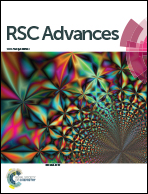Delivery of dexamethasone from electrospun PCL–PEO binary fibers and their effects on inflammation regulation
Abstract
Electrospinning of immiscible polymer blends of PCL and PEO has rendered the solid, straight and hydrophobic PCL fibers into porous, hydrophilic microfibers. In this study, electrospun PCL, 11.4%PEO–88.6%PCL and 23.1%PEO–76.9%PCL fibers were loaded with dexamethasone (DEX) without changing the morphology. Their anti-inflammatory properties on Raw 264.7 cells were compared in vitro. All fibers were found biocompatible and the encapsulation of DEX could alleviate the LPS induced inflammation response. Differences in surface topography, chemical composition, wettability and release kinetics among the different fibers collectively affected the regulation of inflammatory related gene expression.


 Please wait while we load your content...
Please wait while we load your content...